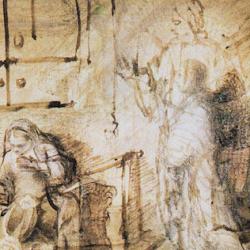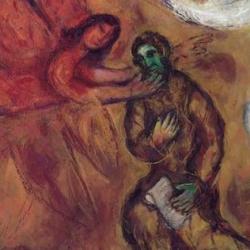Isaiah uses the phrase “in that day” far more than any other writer of the Bible. In the NASB, the phrase appears 40x, 39 of them in the first 31 chapters. Isaiah 1-31 is infused with expectation for the “day of the Lord.”
The phrase occurs in clusters of 3 and 4 in the first 20 chapters of the book, but Isaiah’s “little apocalypse” (chapters 24-27) uses the phrase seven times (24:21; 25:9; 26:1; 27:1; 27:2; 27:12; 27:13). That immediately makes one wonder if the days of the apocalypse correlate with the days of creation. Doesn’t it?
Day 1: Isaiah 24:21 describes the punishment of the host of heaven, the heavenly light, and the extinguishing of the sun and moon. In terms of Israel’s festival calendar, this would correlate with Sabbath. In terms of the temple furnishings, this would link to the throne of God, the ark, established when He casts down the kings of the earth.
Day 2: Isaiah 25:9 announces that the Lord has brought salvation “in that day.” In context, Isaiah has described the removal of a molten covering over the people of the earth (v. 7), a firmament reference. The feast on the mountain that celebrates the deliverance and removes reproach correlates to Passover.
Day 3: Isaiah 26:1 quotes the song of Judah rejoicing over the restoration of the city and its peace. Yahweh proves Himself the “everlasting Rock” (v. 4), the solid ground on which Israel can find stability. This celebration of a resurrected city links to the feast of first sheaf.
Day 4: In Isaiah 27:1, the victory is over the dragon Leviathan, described as a sea monster. But from Revelation 12, we see that the dragon is also a sky monster that Michael casts down to earth. Besides, the serpent is a power or ruler whom Yahweh overcomes with His sword. The passage thus has some Day 4 associations. In festival terms, this would correlate to Pentecost.
Day 5: Isaiah 27:2 describes the Lord’s restoration of His vineyard, and His turn against the briars and thorns that have infested the vineyard. This seems to have more in common with Day 3, but Days 3 and 5 are chiastically connected in Genesis, so it is not unusual for Day 3 elements to show up in Day 5. Festally, this connects to the feast of trumpets, announcing the beginning of the climactic month.
Day 6: Isaiah 27:12 addresses the “sons of Israel” who will be gathered back from the Euphrates and Egypt as a new Adamic people. In terms of Israel’s feasts, this links to the Day of Atonement, and earlier in the chapter Isaiah announces that the iniquity of Jacob has been “covered” ( kapar ; v. 9).
Day 7: Finally, the seventh day is announced by the blast of a great trumpet (27:13), and another announcement of the return from exile. Given its seventh-day position, this verse highlights the Sabbatical nature of the return, the assembly of the people on the “holy mountain at Jerusalem.” It fits neatly with the Feast of Booths, also a feast of ingathering and harvest.
Looking back at that, I’m not satisfied with it. Perhaps it will provoke a response from someone who can do it better.










